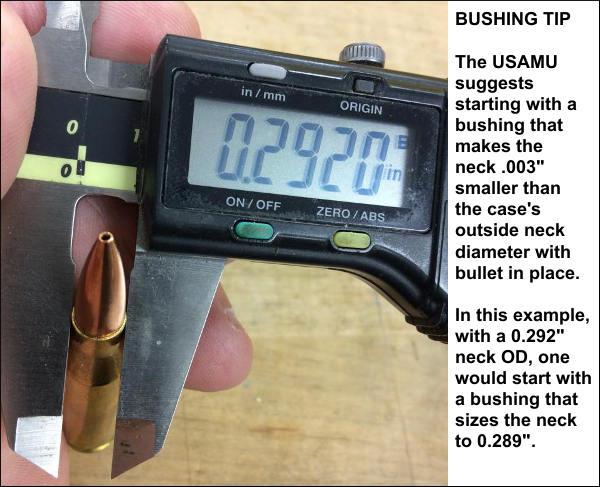Bushing sizing 'tips' can be less than efficient.
Take any loaded round that was partially neck sized, measure the neck OD at sized portion, pull the bullet, and measure the neck OD again. It sprung back (inward) ~1thou (max), right?
That is normal grip, 1/2 to 1thou of spring back. Annealing reduces this from there.
I didn't say how much the bushing neck sizing might have been here, because any amount over 1thou interference doesn't matter, because bullet seating just expanded outward to this normal grip anyway.
Now for sizing down to leave 1thou interference(normal grip), you might use a bushing 2thou under loaded neck OD, which would spring back outward ~1thou afterwards.
There may need to be adjustments in bushing size to get this. If you're downsizing 5thou or greater a bushing can oversize,, over annealing would cause over sizing,, necks greatly work hardened would tend to under size. Very thick necks have more life, more spring back.
Where you intend to expand (Pre-seat) you might use a bushing 3thou under loaded neck OD. The neck springs back from this to ~2thou under. The ideal expander would be AT cal, and spring back from cal expansion would then be what it will be anyway (~1thou under cal). Only this was handled without using bullets for expanders. They are not good for this, it's not good for them.
Either direction, sizing never occurs until you cause yielding, which is anything greater than the actual brass spring back. Brass rarely springs a full 1thou,, new Lapua is usually ~1/2 to 3/4thou. So it's useful to use whole thousands because this is greater than actual -causing brass change as described.
It gets a lot different with something like 20thou+ thickness in WSSM necks, or 8thou thickness as turned and freshly annealed 6PPC necks..
So being able to select bushings to get exactly what you want is an advantage to bushing dies. After all, some of this is trial & error.
A problem here is that many common mandrel sizes are too small. They're less than cal in diameter, because most reloading tool manufacturers fail to account for spring backs, and rational/efficient sizings.
Another problem is that we have no direct measure of spring back grip(tension). We have horeshiit about adjusting neck interference for more or less tension -without understanding or measure. We have the 'pull force' camp who will never understand that pull force/seating force is friction and NOT directly tension(if tension at all). We have a growing annealing mob, who understand nearly nothing about what they're doing, and can't measure what they're causing to hoop tension. Since annealing usually increases seating forces for them, they think they've increased tension. Nope,, just the opposite.. Annealing cannot ever increase tension.
The best we currently have is seating force measure, while friction is managed to a point of standard. However, using actual bullets does not work very well for this, as bullets vary in hardness, and diameters, and possibly friction(unless pre-cleaned).
I get around this with use of a loadcell instrumented mandrel, and I leave carbon residue in fired necks(stable friction coefficient).
I measure & adjust to match seating forces, through sizing lengths, before seating bullets.
But I do realize this is not direct measure of actual tension.
Maybe some day we'll be able to do that, hopefully cheaply, and then many reloaders would benefit in both understanding and function.


